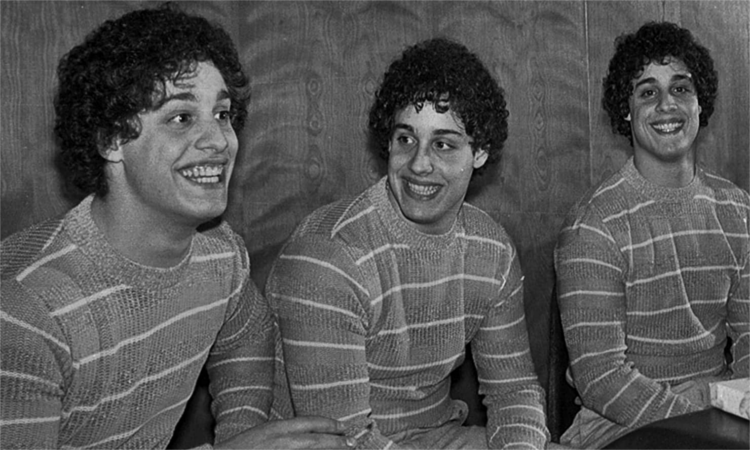Film Review | Three Identical Strangers – A Shocking True Story
A recurring archive clip in new documentary Three Identical Strangers sees an interviewer speaking to orphaned twins separated at birth but now reunited. He says to the pair: “Your story is like a Disney movie,” onIy to receive the reply: “It’s a little darker than a Disney movie.” This interaction sums up Three Identical Strangers, a film which looks beyond what at first appears to be a miracle, finding a surprisingly sinister origin.
In 1980, orphan Bobby Shafran embarked on his first day of college. Despite having lived his life 110 miles away, a number of students approached him, talking to him as if he already knew them. These strangers also were calling him Eddy. Turns out, the previous year his identical twin Eddy Galland – of who he had no knowledge – graduated from the same college. The story made the papers and it wasn’t long before another identical twin, David Kellman, came forward.
Upon meeting, the triplets became overnight sensations, appearing on talk shows together – discussing their similarities – they all wrestled in high school, smoked the same brand of cigarettes, loved Chinese food, had the same taste as women etc. Their fame made them regulars at Studio 54, led them to appear in movies and enabled them to open a restaurant together.
However, all is not perfect. Delving deeper into the phenomenon, the triplets learned they were deliberately split up at birth and used as “lab rats,” by Peter B. Neubauer, an Australian child psychiatrist and former director of the Jewish Board of Family and Children’s Services. Why? To discover once and for all what wins in the nature/nurture battle.
The story at the heart at Three Identical Strangers is a gripping one. It’s filled with riddles that boggle people’s minds. What shapes us? Can one’s life be predetermined? What is more important – the advancement of human understanding or a small handful of peoples’ lives? While most of these questions are just inherent to the true story, director Tim Wardle (with a background in Channel 4 documentaries) and his team of editors deserve credit for assembling the various interviews they conducted and the information they gathered in a way which maxmimises their effect.
The first thirty minutes is the most infectiously upbeat piece of cinema you will see all year – focusing on the brothers’ discovery of each other, their sheer unadulterated joy at the revelation and how they capitalised on it. As David’s aunt Hedy – who is just the sweetest talking head – describes: “The first time the three boys met it was in my house and they ended up like puppies wrestling on the floor. It was incredible. They belonged to each other.” Her description is enough to bring tears of joy to one’s eye.
The euphoric mood is so palpable that when the penny drops, viewers feel the betrayal the same way the triplets do. The film evolves into a conspiracy thriller, filled with moments that could have been in Errol Morris’ documentary from last year Wormwood, another unbelievable story about American secret experiments.

The parents of each of the trio visited the adoption agency to understand just what happened. They were told that the reason the triplets were split up was because it made each baby easier to adopt. Not satisfied, the parents left angry. However, one in the group forgot their umbrella. Returning to the room, the person saw representatives from the agency toasting each other with champagne ‘as if they had dodged a bullet.’
If Three Identical Strangers has a flaw, it is similar to Wormwood’s. Definitive answers can never be uncovered. In its final third, the documentary shifts into a quest to discover what the exact purpose of Neubauer’s study was. However, the psychiatrist died in 2008, taking steps before to make sure his research could never be fully recovered. Also, frustrating is the fact that Neubauer is the most interesting piece of the puzzle. He was an Austrian-Jew who fled Europe during WWII only to take part in experiments which have drawn comparisons to that of the Nazis.
However, while this could be completely anti-climactic, the film overcomes the dead end by never shifting too far away from the story of the central triplets. Everything comes to a gut-wrenching denouement. It’s one that uses the trio’s story to choose a side in the nature/nurture debate. It does so more convincingly than any of Neubauer’s available data.

